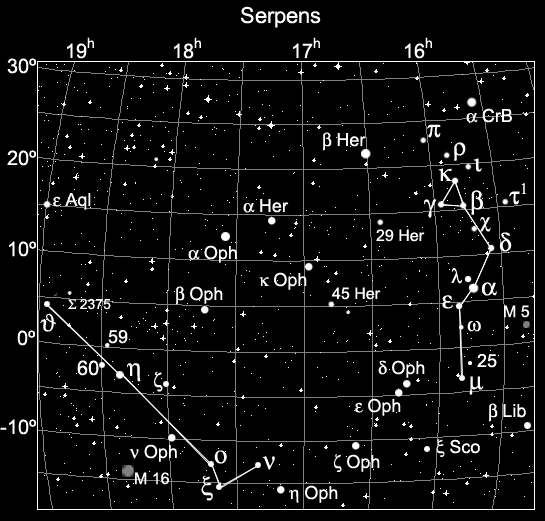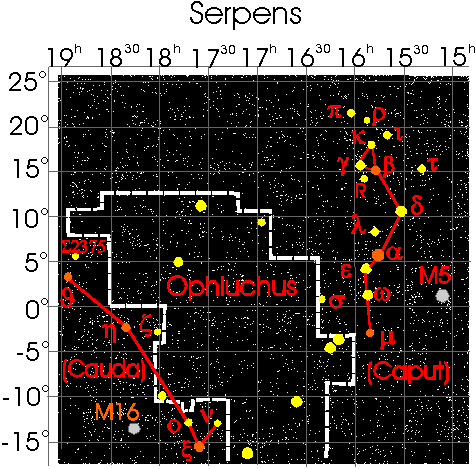
Serpens is an oddity: the only constellation interrupted by another. Half way down the serpent it crosses Ophiuchus and finishes on the other side of this constellation. There is, however, a reason for this interruption. Ophiuchus is known as ‘the serpent holder’. He was also a mythical healer, an ancient medical man. The constellation representing Ophiuchus shows him grasping the serpent, which is therefore spread across the body of Ophiuchus. In fact, the snake that Ophiuchus is holding has entered modern medicine as the symbol of medicine, known as the caduceus: a staff with two winding snakes. And so when we study Serpens we'll also have to recognise at least part of Ophiuchus. >The constellation has some fine binaries for binoculars as well as two Messier objects, both star clusters. A prerequisite study of Corona Borealis would be indicated.

Alpha Serpentis is called Unukalhai, the Serpent's Neck although in the Middle Ages the star was also known as ‘Cor Serpentis’. the Serpent's Heart. This yellow giant is about half-way down the western portion of the constellation, one binocular field south of delta. Nearly eight degrees to the southwest (just out of binocular FOV from alpha) is M5, a very fine globular gluster of over half a million stars tightly grouped. It's easiest to find if you first start from omega Serpentis, at the bottom of your glasses. Place omega at the eastern edge of your glasses; 10 Serpentis will appear at the other edge. Move further westward until 10 Ser is nearly at the eastern edge; M5 will be centered. The cluster is thought to be more than ten billion years old.
Beta Serpentis is found in the head of the serpent, and serves to first locate the beast. From Corona Borealis drop due south two full binocular FOVs. You will come across the serpent's head. Beta is a wide yet difficult double, as the brightness of the primary (3.7) impedes the detection of the companion, a yellow dwarf with a magnitude of only 9.2. The position angle is 265º with a separation of 31". Now follow the serpent's body down to alpha, first visiting delta.
Eta Serpentis is half-way up the 'tail' of the serpent, the eastern portion of the constellation. Farther to the northeast is found theta, a delicate due of white stars nicely resolved in small telescopes or large binoculars. To find eta, start from the triangle of stars at the southern tip of Serpens Cauda. Place omicron at the opposite (southwestern) side of your glasses and nu Ophiuchi appears. Now if you put this last star (nu Oph) at the bottum of your glasses, you'll find zeta Serpentis (fairly faint) at the top. Place this star at the western edge of your glasses and the much brighter eta Ser comes into view. Center on this star. Theta is two fields to the northeast.
Mu Serpentis is the terminus of the western portion of Serpens. From alpha Serpentis find omega at the bottom of your glasses, then place this star at the top. Now you'll have to starhop across Ophiuchus. Due east of mu Serpentis are two bright stars, found in Ophiuchus. These are delta and epsilon; they represent Ophiuchus' left hand as he holds the serpent. From these two stars move to the southeast about ten degrees; this is zeta Ophiuchi. Now move the same distance in a more east-southeasterly direction. You'll come to eta Ophiuchi and are ready to move into Serpens Cauda, the Serpent's Tail. From eta Ophiuchi move due east one binocular field. You'll encounter a very noticeable stellar triangle.
Theta Serpentis is a beautiful binary of two white stars: 3.7, 9.3; PA 103º and a separation of 22", clearly resolved in small telescopes and larger binoculars. The star marks the tip of the serpent's tail, and is found three right-ascension hours east of alpha. It's easier, and much more fun, to follow the serpent's form, from head to tail, finally coming to theta, which is two binocular fields of view northeast of eta Serpentis or a little more than three fields due east of beta Ophiuchi You may need some patience to return to your observation post several hours after you've followed the Serpens Caput portion of the constellation, in order to then complete the study of the Serpent. But if you have a small telescope or large binoculars, theta is worth the wait. In the same field, west of theta, is the cluster of about 80 stars known as I.4756, widely dispersed.
Xi Serpentis is the star the farthest to the south in the Serpens asterism. You are now in the eastern portion, called ‘The Serpent’s Tail’. The star to the northwest here, nu Serpentis, is a binocular binary with a ninth magnitude wide companion. The asterism now climbs to the northeast, again briefly crossing Ophiuchus. Place omicron at the southwestern edge of your glasses. The star you see at the northeastern corner is nu Ophiuchi. From nu Ophiuchi move two fields to the northeast; you'll encounter eta Serpens in a rather lonely part of the skies. From nu Ophiuchi you can also find M16, which is southwest about eight degrees.
